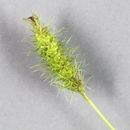Comprehensive Description
provided by North American Flora
Carex frankii Kunth, Enum. PI. 2: 498. 1837
Carex alherodes Frank; Kunth, Enum. PI. 2: 498, as synonym. 1837.
Carex slenolepis Torr. Ann. Lye. N. Y. 3: 420. 1836. (Type from Kentucky.) Not C. slenolepis Less. 1831.
Carex Shortii Steud. Nom. Bot. ed. 2. 296. 1840. (Type from Kentucky.) Not C. Shortiana Torr. 1836.
Carex aurolensis Steud. Syn. Cyp. 223. 1855. (Type from New Orleans, Louisiana.)
Carex involucrala Bock. Flora 38: 594. 1855. (Type from Texas.)
Carex slenolepis var. Boott, 111. Carex 96. 1860. (Type from Louisiana and Alabama.)
Carex atrovirens Bock. Cyp. Nov. 1 : 52. 1888. (Type from Argentina.)
Carex slenolepis f. gracilior Kiikenth. in Engler, Pllanzenreich, 4 20 : 715. 1909. (Based on C. slenolepis var. Boott.)
Cespitose, with short-ascending, stout, tough stolons, the culms 1-8 dm. high, stiff, stout, erect, leafy throughout, aphyllopodic, obtusely triangular with flattish sides, purplish-tinged at base, the dried-up leaves of the previous year few; sterile shoots elongate, leafy; leaves and bracts numerous, septate-nodulose, the blades rather light-green, firm, flat, 2-6 dm. long, 3-10 mm. wide, short-tapering, rough above and on the margins, the sheaths tight, yellowish-browntinged ventrally and truncate at mouth, the ligule somewhat longer than wide to shorter than wide; staminate spike solitary, largely hidden, not infrequently abortive, short, slenderly peduncled, setaceous-bracted, narrowly linear, 0.5-3 cm. long, 2-3 mm. wide, sometimes with some perigynia, its scales narrowly linear-oblanceolate, long-awned, hyaline with 3-nerved green center; pistillate spikes 3-7, approximate or the lower more or less strongly remote, erect, the upper sessile or short-exsert-peduncled, the lower more or less strongly exsert-peduncled, the rachis zigzag, the peduncles stiff, smooth, the spikes oblong, 1-4 cm. long, 8-12 mm. wide, very densely flowered, the 40-120 perigynia squarrose in many rows, the lower scales and sometimes the uppermost often empty or staminate; bracts very long and conspicuous, leaf -like, many times exceeding the culms, at least the lower strongly sheathing; scales very long, aristiform, but little dilated and hyaline at base, green, 3-nerved, setulose, equaling or exceeding but much narrower than the beaks of the perigynia; perigynia 4-5 mm. long, the body strongly obconic, 2-2.5 mm. wide, inflated, submembranaceous, glabrous, puncticulate, olivegreen, strongly 12-20-ribbed, tapering at base, sessile, depressed-truncate above, very abruptly beaked, the beak 1.5-2.5 mm. long, slender, conic, smooth, bidentate, the teeth stiff, erect or somewhat spreading, 0.5 mm. long; achenes very small, obovoid, 1.5 mm. long, 1 mm. wide, triangular with blunt angles, loosely enveloped in lower half of perigynium-body, concave below, granular, brownish-yellow, substipitate, abruptly contracted into and continuous with the straight, slender, persistent style; stigmas 3, slender, very short, light-yellowish-brown.
Type locality: "Baltimore, Pennsylvania."
Distribution: Swamps and wet meadows, in calcareous districts, Texas to Georgia, north to eastern Pennsylvania, western New York, Illinois, and Kansas; also in South America. (Specimens examined from New York, Pennsylvania, Maryland, District of Columbia, West Virginia. Virginia, North Carolina, Georgia, Alabama, Mississippi, Ohio, Indiana, Illinois, Kentucky, Tennessee, Missouri, Kansas, Arkansas, Oklahoma, Louisiana, Texas.)
- bibliographic citation
- Kenneth Kent Mackenzie. 1935. (POALES); CYPERACEAE; CARICEAE. North American flora. vol 18(7). New York Botanical Garden, New York, NY

